An Optical Power Divider Based on Mode Coupling Using GaN/Al2O3 for Underwater Communication †
Abstract
1. Introduction
2. Proposed Design of the GaN-Based Optical Power Divider and Numerical Analysis
2.1. The Proposed Design of the Optical Power Splitter
2.2. Numerical Analysis
3. Simulation Results and Discussion
4. Conclusions
Author Contributions
Funding
Conflicts of Interest
References
- Kaushal, H.; Kaddoum, G. Underwater Optical Wireless Communication. IEEE Access 2016, 4, 1518–1547. [Google Scholar] [CrossRef]
- Zeng, Z.; Fu, S.; Zhang, H.; Dong, Y.; Cheng, J. A Survey of Underwater Optical Wireless Communications. IEEE Commun. Surveys Tuts. 2017, 19, 204–238. [Google Scholar] [CrossRef]
- Fujihashi, T.; Saruwatari, S.; Watanabe, T. Multiview Video Transmission Over Underwater Acoustic Path. IEEE Trans. Multimedia 2018, 20, 2166–2181. [Google Scholar]
- Hoeberechts, M.; Owens, D.; Riddell, D.J.; Robertson, A.D. The power of seeing: Experiences using video as a deep-sea engagement and education tool. In Proceedings of the MTS/IEEE Oceans, Washington, DC, USA, 19–22 October 2015. [Google Scholar]
- Kang, J.H.; Wenzel, H.; Hoffmann, V.; Freier, E.; Sulmoni, L.; Unger, R.S.; Einfeldt, S.; Wernicke, T.; Kneissl, M. DFB Laser Diodes Based on GaN Using 10th Order Laterally Coupled Surface Gratings. IEEE Photon. Technol. Lett. 2018, 30, 231–234. [Google Scholar] [CrossRef]
- Liu, J.; Zhang, L.; Li, D.; Zhou, K.; Cheng, Y.; Zhou, W.; Tian, A.; Ikeda, M.; Zhang, S.; Yang, H. GaN-Based Blue Laser Diodes With 2.2 W of Light Output Power Under Continuous-Wave Operation. IEEE Photon. Technol. Lett. 2017, 29, 2203–2206. [Google Scholar] [CrossRef]
- Tian, P.; Liu, X.; Yi, S.; Huang, Y.; Zhang, S.; Zhou, X.; Hu, L.; Zheng, L.; Liu, R. High-speed underwater optical wireless communication using a blue GaN-based micro-LED. Opt. Express 2017, 25, 1193–1201. [Google Scholar] [CrossRef] [PubMed]
- Cai, Y.; Zou, X.; Liu, C.; Lau, K.M. Voltage-Controlled GaN HEMT-LED Devices as Fast-Switching and Dimmable Ligh Emitters. IEEE Electron Device Lett. 2018, 39, 224–227. [Google Scholar] [CrossRef]
- Hou, M.; So, H.; Suria, A.J.; Yalamarthy, A.S.; Senesky, D.G. Suppression of Persistent Photoconductivity in AlGaN/GaN Ultraviolet Photodetectors Using In Situ Heating. IEEE Electron Device Lett. 2017, 38, 56–59. [Google Scholar] [CrossRef]
- Velazquez, R.; Aldalbahi, A.; Rivera, M.; Feng, P. Fabrications and application of single crystalline GaN for high-performance deep UV photodetectors. AIP Adv. 2016, 6, 085117. [Google Scholar] [CrossRef]
- Oubei, H.M.; Duran, J.R.; Janjua, B.; Wang, H.Y.; Tsai, C.T.; Chi, Y.C.; Ng, T.K.; Kuo, H.C.; Alouini, H.M.S.; Lin, G.R.; et al. 4.8 Gbit/s 16-QAM-OFDM transmission based on compact 450-nm laser for underwater wireless optical communication. Opt. Express 2015, 23, 23302–23309. [Google Scholar] [CrossRef]
- Raymond, C.; Baker, S.; Baker, K.S. Optical properties of the clearest natural waters (200–800 nm). Appl. Opt. 1981, 20, 177–184. [Google Scholar]
- Zaken, B.B.; Zanzur, Y.T.; Malka, D. An 8-channel wavelength MMI demultiplexer in slot waveguide structures. Materials 2016, 9, 881. [Google Scholar] [CrossRef] [PubMed]
- Malka, D.; Sintov, Y.; Zalevsky, Z. Design of a 1 × 4 silicon-alumina wavelength demultiplexer based on multimode interference in slot waveguide structures. J. Opt. 2015, 17, 125702. [Google Scholar] [CrossRef]
- Kim, K.S.; Vuong, Q.V.; Kim, Y.; Kwon, M.S. Compact Silicon Slot Waveguide Intersection Based on Mode Transformation and Multimode Interference. IEEE Photon. J. 2017, 6, 4502910. [Google Scholar] [CrossRef]
- Fan, G.; Li, Y.; Han, B. A Wide Wavelength Range of 1 × 8 Optical Power Splitter with an Imbalance of Less Than ±1.0 dB on Silicon-on-Insulator Technology. IEEE Photon. J. 2017, 9, 6601905. [Google Scholar] [CrossRef]
- Rakshitha, M.; Sridarshini, T.; Gandhi, I. Photonic Crystal Ring resonator based 1x4 Optical power splitter. In Proceedings of the International Conference on Recent Trends in Electrical, Control and Communication (RTECC), Kuala Lumpur, Malaysia, 20–22 March 2018. [Google Scholar]
- Yuan, Z.; Wang, K. Ultrabroadband, low loss and polarization independent silicon nitrite integrated optical power splitter. In Proceedings of the Asia Communications and Photonics Conference (ACP), Hangzhou, China, 26 October 2018. [Google Scholar]
- Wang, Y.; Gaol, S.; Wang, K.; Skafidas, E. Ultra-broadband and Low-loss Optical Power Splitter Based on Tapered Silicon Waveguides. In Proceedings of the IEEE Optical Interconnects Conference (OI), San Diego, CA, USA, 20–22 April 2015. [Google Scholar]
- Sun, W.; Tan, C.K.; Tansu, N. III-Nitride Digital Alloy: Electronics and Optoelectronics Properties of the InN/GaN Ultra-Short Period Superlattice Nanostructures. Sci. Rep. 2017, 7, 6671. [Google Scholar] [CrossRef]
- Coulon, P.M.; Pugh, J.R.; Athanasiou, M.; Kusch, G.; Leboulbar, E.D.; Sarua, A.; Smith, R.; Martin, W.; Wang, T.; Cryan, M.; et al. Optical properties and resonant cavity modes in axial InGaN/GaN nanotube microcavities. Opt. Express 2017, 25, 28246–28257. [Google Scholar] [CrossRef]
- Jain, S.C.; Willander, M.; Narayan, J.; Van Overstraeten, R. III–nitrides: Growth, characterization, and properties. J. Appl. Phys. 2000, 87, 965. [Google Scholar] [CrossRef]
- Purnamaningsih, R.W.; Poespawati, N.R.; Saraswati, I.; Dogheche, E. Design of GaN-based Low Loss Y-Branch Power Splitter. MJT 2015, 18, 101–106. [Google Scholar]
- Purnamaningsih, R.W.; Poespawati, N.R.; Dogheche, E. Design of a four-branch optical power splitter using III-nitride semiconductors. In Proceedings of the International Conference on Telecommunications and Communication Engineering, Osaka, Japan, 22–24 October 2017. [Google Scholar]
- Sekiya, T.; Sasaki, T.; Hane, K. Design, fabrication, and optical characteristics of freestanding GaN waveguides on silicon substrate. J. Vac. Sci. Technol. B Nanotechnol. Microelectron. 2015, 33, 031207. [Google Scholar] [CrossRef]
- Gao, X.; Shi, Z.; Jiang, Y.; Zhang, S.; Qin, C.; Juan, Y.; Liu, Y.; Grünberg, P.; Wang, Y. Monolithic III-nitride photonic integration toward multifunctional devices. Opt. Lett. 2017, 42, 4853–4856. [Google Scholar] [CrossRef] [PubMed]
- Purnamaningsih, R.W.; Poespawati, N.R.; Dogheche, E. III-nitride semiconductors based optical power splitter device design for underwater application. IJECE 2018, 5, 3866–3874. [Google Scholar] [CrossRef]
- Purnamaningsih, R.W.; Hamidah, M.; Fithriaty, D.; Gumelar, M.R.; Poespawati, N.R.; Dogheche, E. A GaN/sapphire 1 × 4 Optical Power Splitter Using Five Rectangular Waveguide for Underwater Application. In Proceedings of the IEEE 5th International Conference on Engineering Technologies and Applied Sciences (ICETAS), Bangkok, Thailand, 22–23 November 2018. [Google Scholar]
- Haus, H.A.; Huang, W.P. Coupled-Mode Theory. Proc. IEEE 1991, 79, 1505–1518. [Google Scholar] [CrossRef]
- Huang, W.P. Coupled-mode theory for optical waveguides: an overview. J. Opt. Soc. Am. A 1994, 11, 3. [Google Scholar] [CrossRef]
- Little, B.E.; Huang, W.P. Coupled-mode theory for optical waveguides. PIER 1995, 10, 217–270. [Google Scholar]
- Stolz, A.; Cho, E.; Dogheche, E.; Androussi, Y.; Troadec, D.; Pavlidis, D.; Decoster, D. Optical waveguide loss minimized into gallium nitride based structures grown by metal organic vapor phase epitaxy. Appl. Phys. Lett. 2011, 98, 161903. [Google Scholar]
- OptiBPM “Technical Background and Tutorials” Waveguide Optics Modeling Software System, Version 9.0, Optiwave Inc. Available online: https://optiwave.com/optibpm-manuals/ (accessed on 23 May 2019).


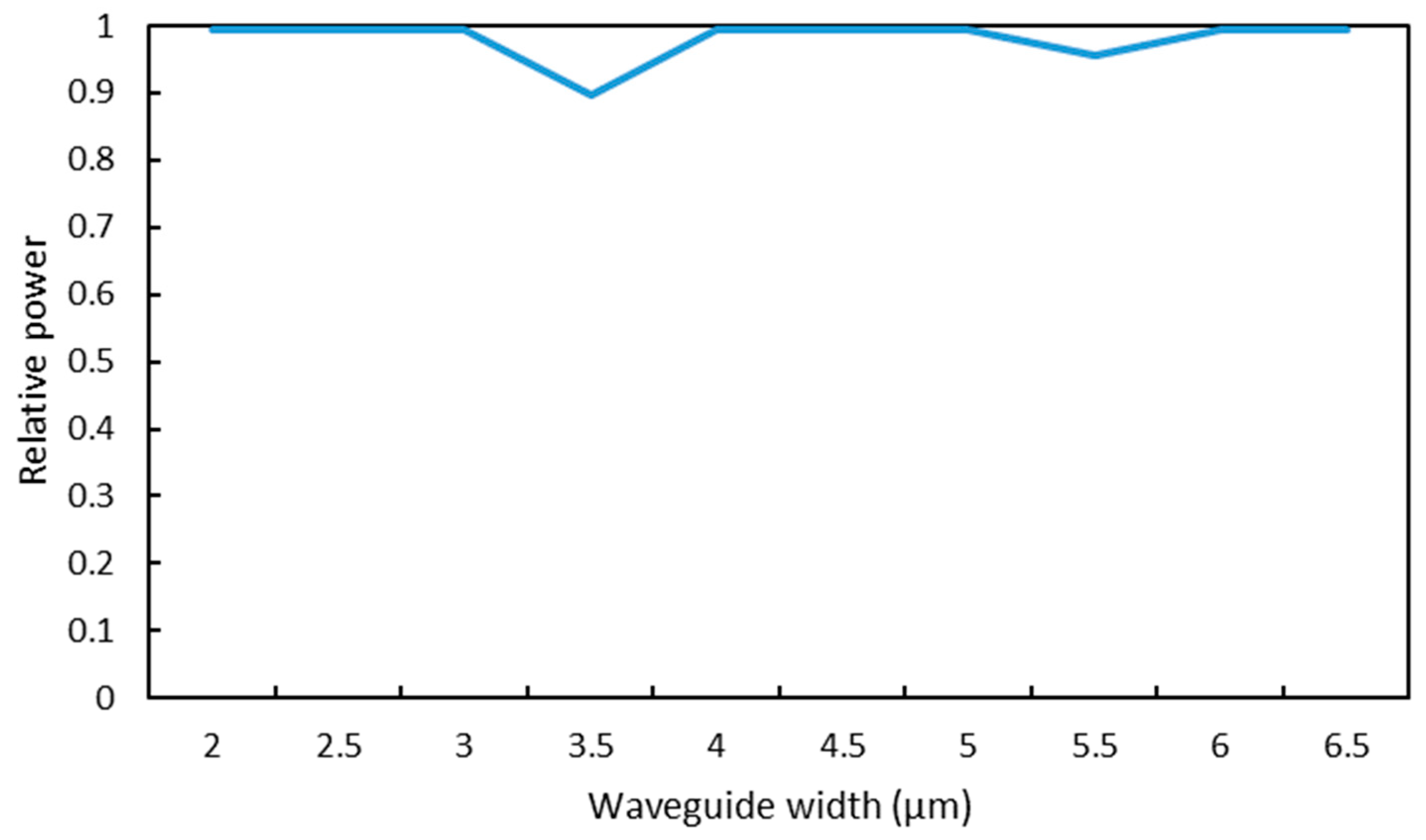
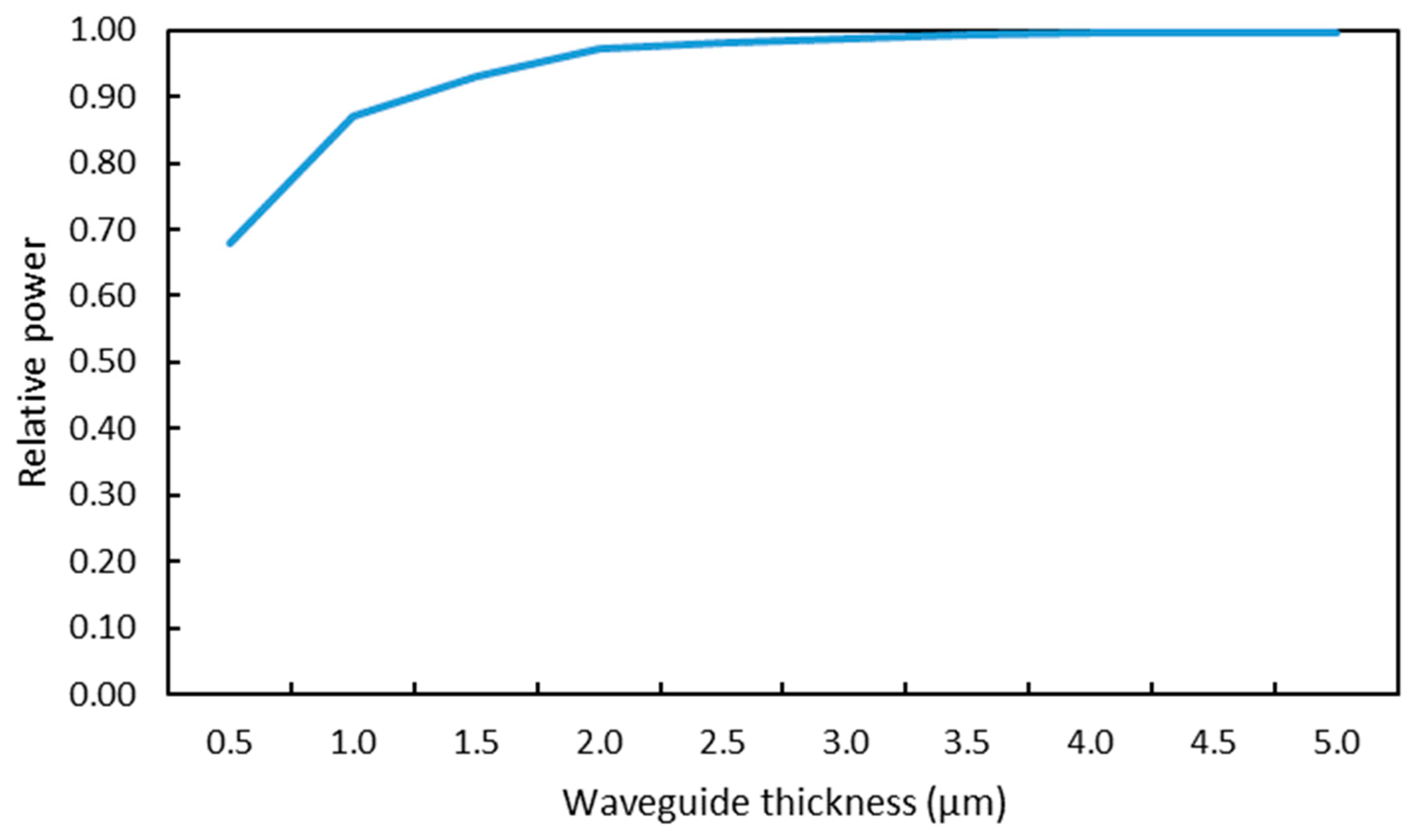
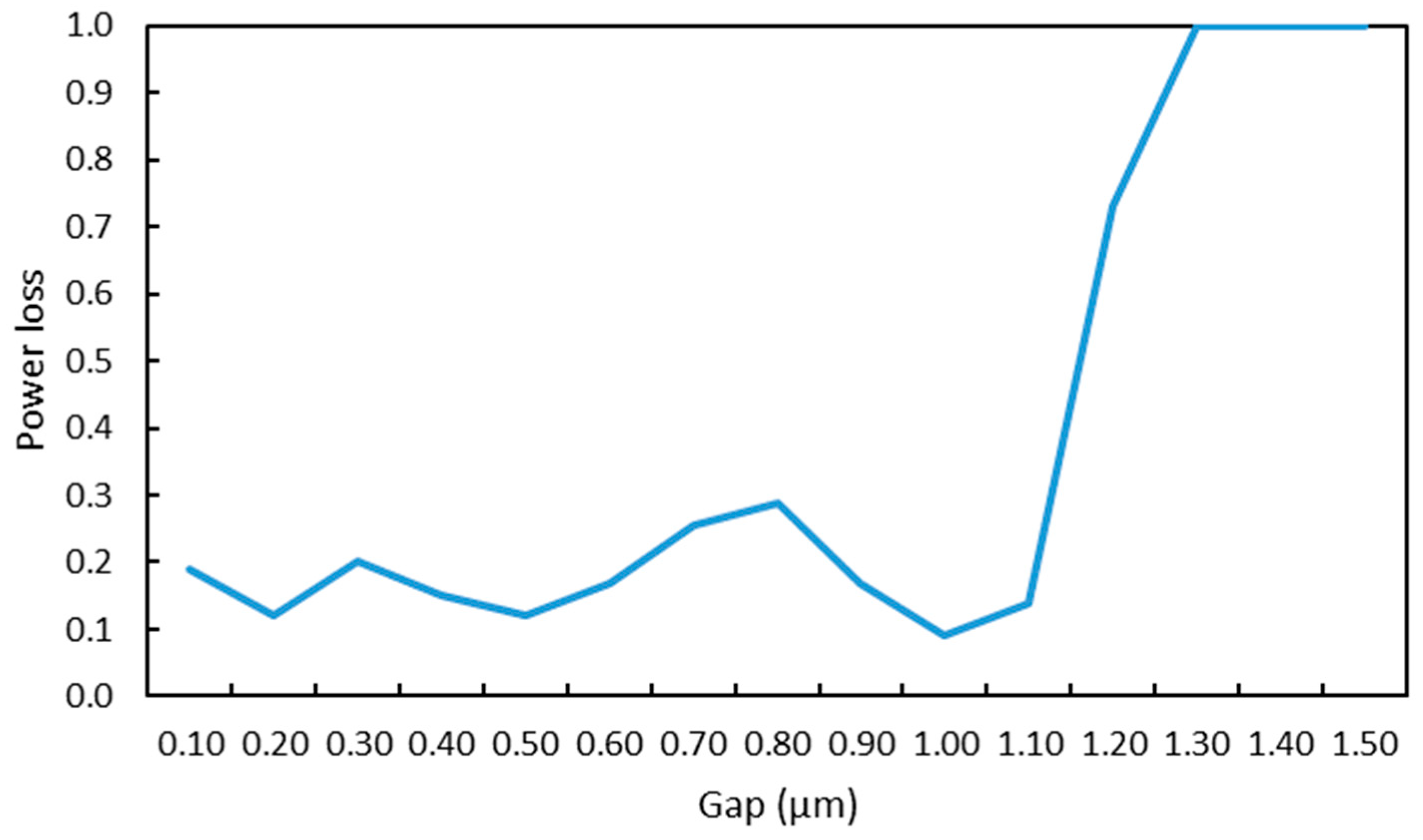
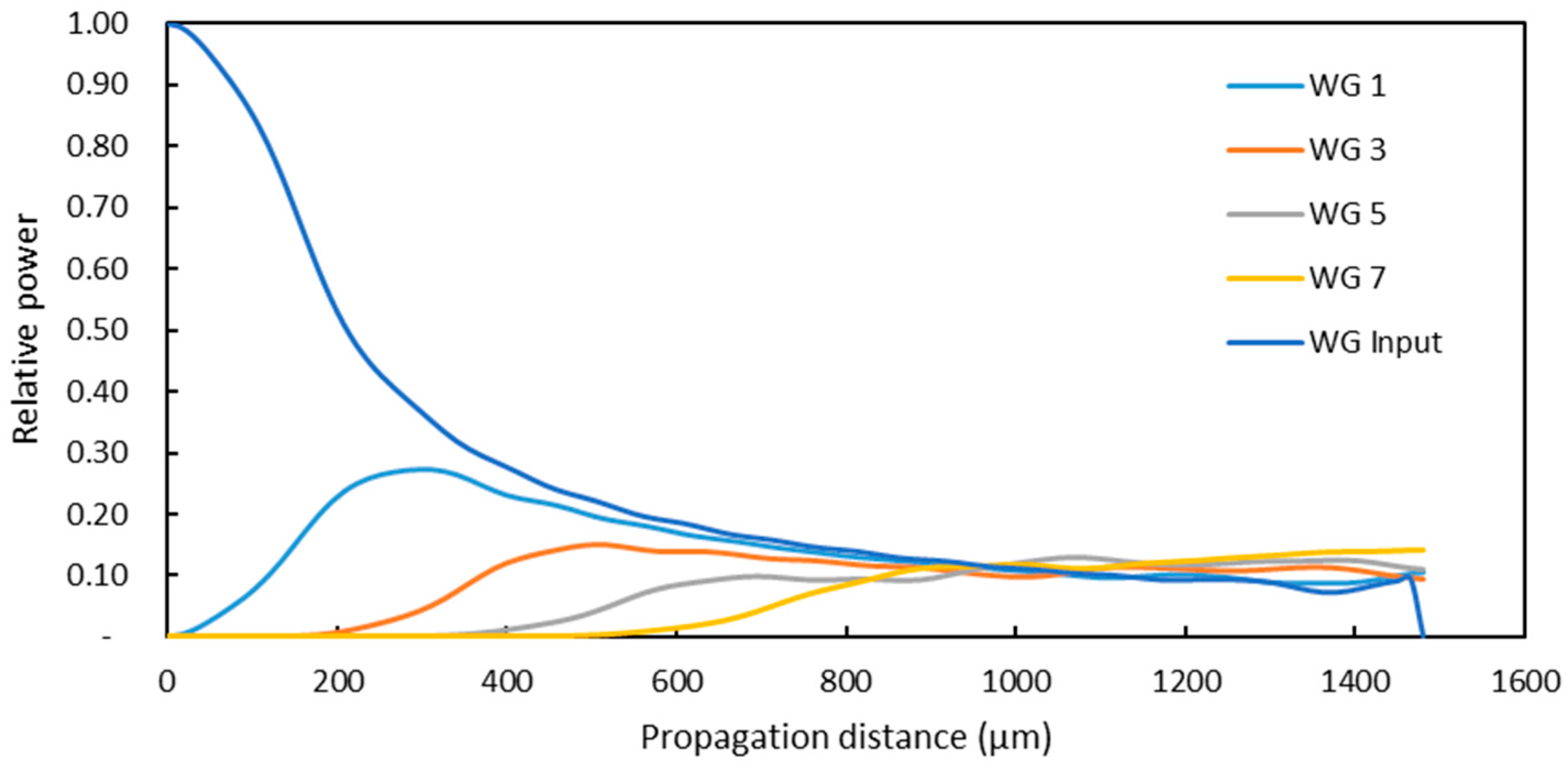


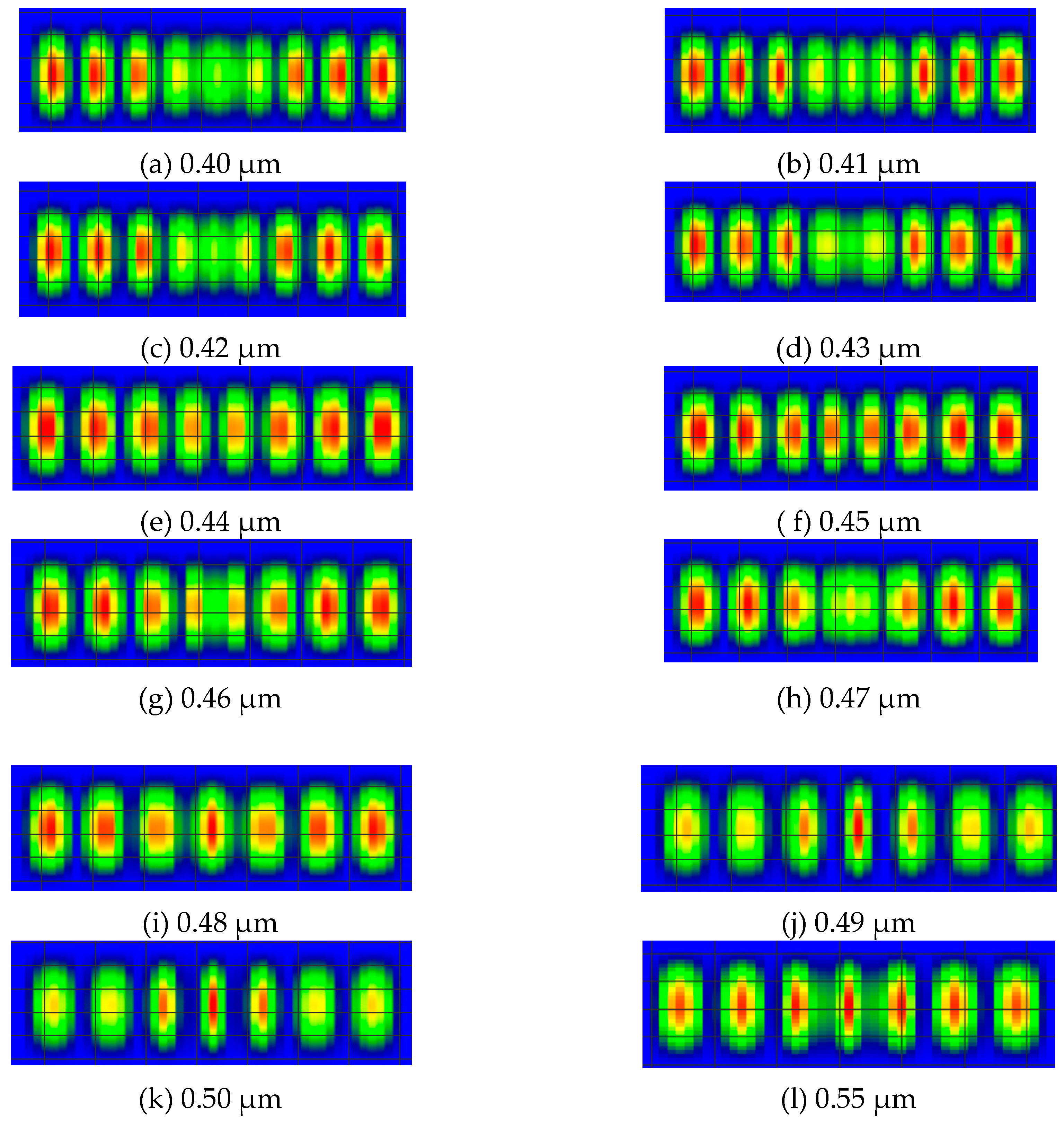
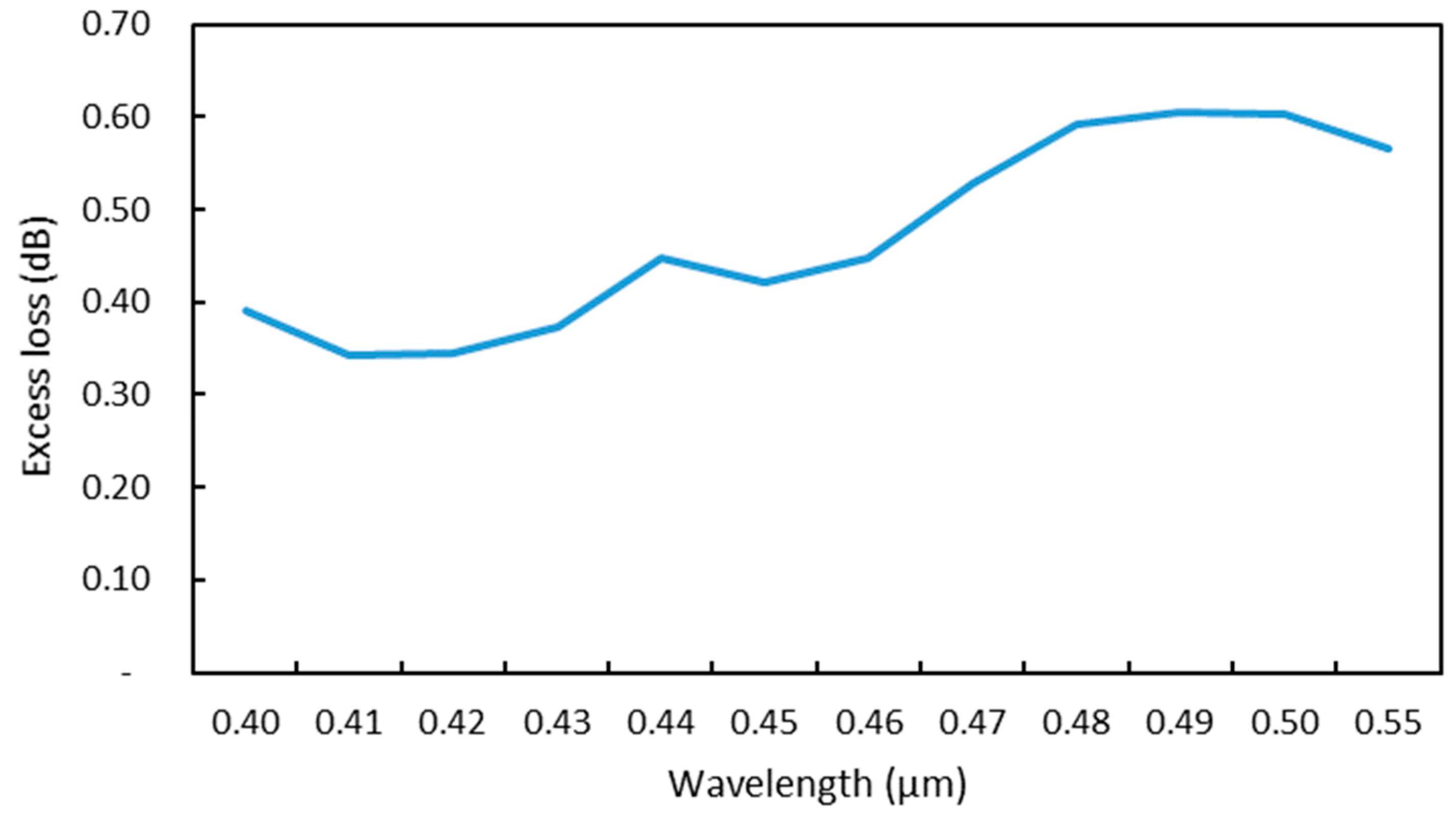
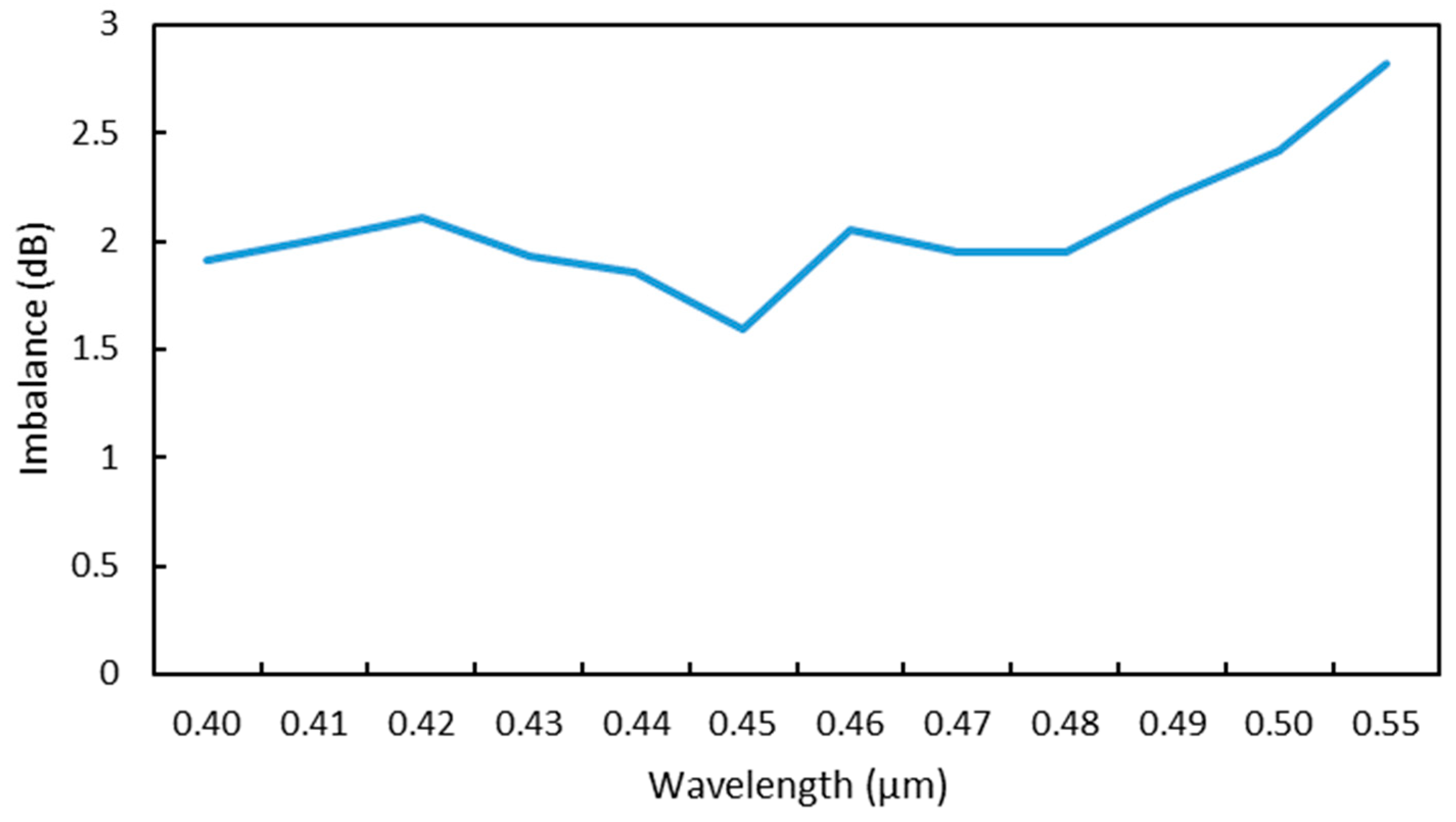
| Material Structure | Width | Thickness | Refractive Index |
|---|---|---|---|
| Cladding (Air) | 100 µm | 10 µm | 1 |
| GaN | 4 µm | 4 µm | |
| AlN/GaN interlayer | 100 µm | 0.2 µm | 2.45 |
| AlN buffer layer | 100 µm | 0.3 µm | |
| Sapphire(Al2O3) substrate | 100 µm | 5 µm | 1.76 |
© 2019 by the authors. Licensee MDPI, Basel, Switzerland. This article is an open access article distributed under the terms and conditions of the Creative Commons Attribution (CC BY) license (http://creativecommons.org/licenses/by/4.0/).
Share and Cite
Purnamaningsih, R.W.; Poespawati, N.R.; Abuzairi, T.; Dogheche, E.
An Optical Power Divider Based on Mode Coupling Using GaN/Al2O3 for Underwater Communication
Purnamaningsih RW, Poespawati NR, Abuzairi T, Dogheche E.
An Optical Power Divider Based on Mode Coupling Using GaN/Al2O3 for Underwater Communication
Purnamaningsih, Retno Wigajatri, Nji Raden Poespawati, Tomy Abuzairi, and Elhadj Dogheche.
2019. "An Optical Power Divider Based on Mode Coupling Using GaN/Al2O3 for Underwater Communication
Purnamaningsih, R. W., Poespawati, N. R., Abuzairi, T., & Dogheche, E.
(2019). An Optical Power Divider Based on Mode Coupling Using GaN/Al2O3 for Underwater Communication





